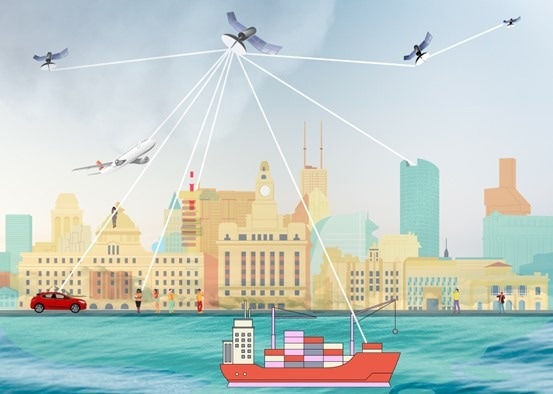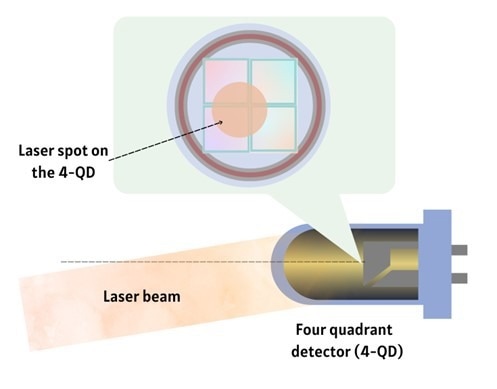A newly developed optical receiver detects the direction of the incident laser beam. This technological advancement, introduced by the Mitsubishi Electric Corporation, will have a significant impact on future optical space communications.

Image Credit: Vadim Sadovski/Shutterstock.com
Space exploration has thrived since the first space flight several decades ago. Along with scientific inquiry, recent commercial space travel has brought many government and private companies into the space industry.
Government efforts in optical space communications involve developing communication links between GEO satellites, spacecraft and ground-based stations. The European Data Relay System (EDRS) and the Laser Communication Relay Demonstration (LCRD) are European Space Agency’s and NASA’s space communication projects, respectively.
Corporations such as Boeing, Airbus, SpaceX and LeoSat Enterprises are examples of private entities that have entered the industry to facilitate commercial space flights.
Rapidly growing space activities have increased the data traffic in space communications. Approximately 3,400 active satellites are used in applications such as mobile phones, GPS navigation as well as in industrial R&D. Each satellite uses a unique radio frequency (RF) to transmit data. As a result, the availability of RF bandwidths for new space technology has diminished.
Optical Communication in Space
Optical communication uses infrared (IR) laser light to transmit data. In IR communication, like in RF, data is encoded into electromagnetic signals and transmitted to different stations. But unlike RF, IR transmission can store more data and transfer them at higher speeds. This is due to the higher frequency region in which IR is operated as compared to RF.
Data transfer rates are expected to be 10 to 100 times faster in optical communications when compared to RF.
When using free-space laser beams in optical applications, the alignment of the beam is critically important. Misalignments result in less efficient data transfer. In a complex cluster of communication infrastructure as illustrated in figure 1, misaligned laser beams can quickly multiply to be a disadvantage.

Figure 1: Image showing a complex communication infrastructure. Image Credit: Ilamaran Sivarajah
Optical Receiver with Spatial Acquisition
Mitsubishi Electric Corporation has developed an optical receiver prototype to circumvent the challenges in beam alignment. The new optical receiver integrates a function to detect the direction of the incident laser beam with space optical communication components. These prototypes can be installed on any laser communication terminals (LCTs).
In general, a photoelectric detector converts the laser light it receives into electric signals. These electric signals are read out on an oscilloscope and proportional values are assigned to the strength of the signals. Spatial information of the laser beam cannot be conclusively inferred from such measurements.
Mitsubishi Electric uses a four-quadrant detector (4-QD) in their new prototype to enhance spatial acquisition. 4-QD detectors are constructed with advanced photolithography technology.
As shown in figure 2, the photoelectric surface of the detector is divided into four quadrants. An incident laser beam forms a spot on the photosensitive surface of the detector that encompasses different portions of the quadrant. Each quadrant records different intensities of electric signals with high precision. These electric signals are consistent with the amount of exposure each quadrant receives. The output signal intensity from each segmented quadrant is compared and calculated to determine the directions of the incident beam.

Figure 2: Laser beam shining on the 4-QD. Inset shows the beam spot on the surface of the 4-QD. Image Credit: Ilamaran Sivarajah
The optical receiver built by Mitsubishi Electric also includes a newly designed optical circuit. The new circuitry is capable of detecting phase changes over 360 degrees. Each segmented quadrant accounts for 0, 90, 180, and 270 degrees. Consequently, 4-QD detectors have much higher communication capacity and speed.
In addition, the optical receiver is contained within a 10 cm^3 enclosure. The compact prototype is configured as a lightweight single module that is easy to transport.
Future Outlook
Mitsubishi Electric’s newest innovation will play a significant role in future space optical communications. The 4-QD detector technology is capable of recognizing the direction in which the laser beam is arriving, which enables the detector to be adjusted carefully to optimize the alignment of the laser beam into the detector. The integrated space optical communication functionality allows linking the many satellites with relay stations and other communication stations.
The higher sensitivity afforded by the 4-QD technology allows it to detect weaker laser beams. This feature facilitates communication over longer distances. Interference from other light sources, such as sunlight and other background noise, can also be filtered more effectively.
Apart from installation in space, the new optical receiver can be installed in hard-to-reach locations on earth and be linked to satellites. For example, within building infrastructures where optical fibers are difficult to install. Communication points can also be set up quickly in disaster zones or remote areas, and high-resolution images can be transferred for rescue missions.
References and Further Reading
Sivarajah, I. (2022) The Use of Lasers for Space Communications. [Online] AZoOptics.com. Available at: https://www.azooptics.com/Article.aspx?ArticleID=2119
Mitsubishi Electric Corporation (2022) Mitsubishi Electric Develops World's First Laser Communication Terminal Integrating Space Optical Communication and Spatial Acquisition. [Online] Mitsubishielectric.com. Available at: https://www.mitsubishielectric.com/news/2022/0531-a.html
Jun Zhang, Weixian Qian, Guohua Gu, Chen Mao, Kan Ren, Chunhong Wu, Xiaoyu Peng, and Qian Chen, "Improved algorithm for expanding the measurement linear range of a four-quadrant detector," Appl. Opt. 58, 7741-7748 (2019) https://doi.org/10.1364/AO.58.007741
Optics.org. (2022) Mitsubishi claims breakthrough for laser communication in space. [Online] Optics.org. Available at: https://optics.org/news/13/6/1
Disclaimer: The views expressed here are those of the author expressed in their private capacity and do not necessarily represent the views of AZoM.com Limited T/A AZoNetwork the owner and operator of this website. This disclaimer forms part of the Terms and conditions of use of this website.